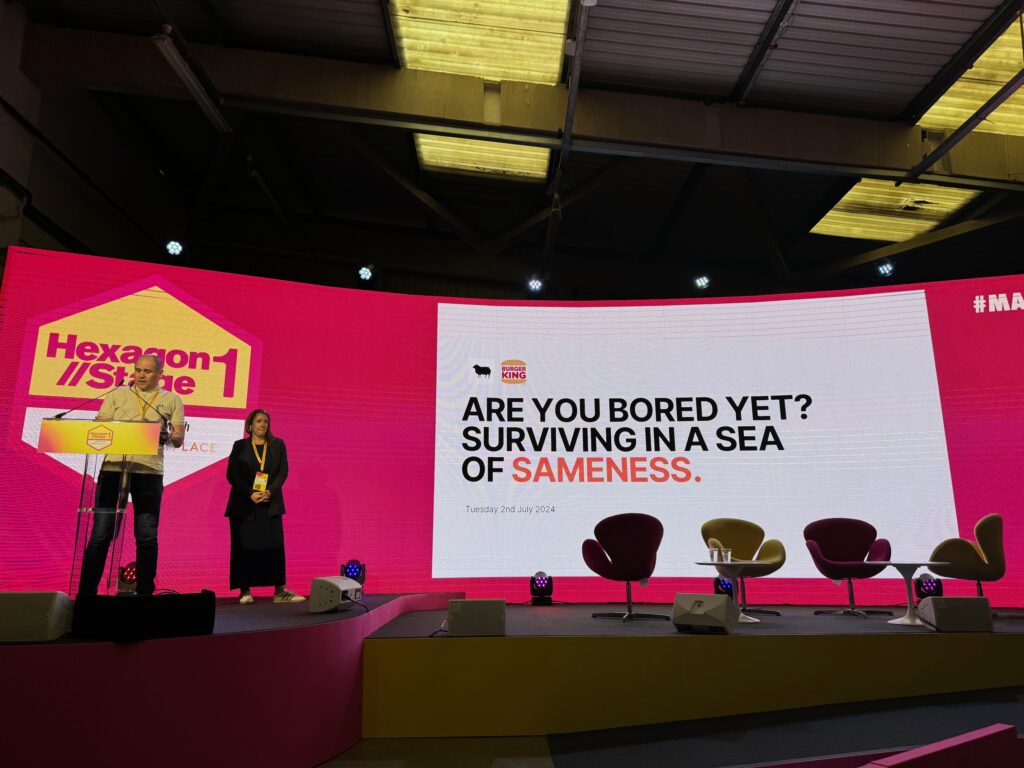It’s a bold move to stand up in front of a room full of marketers and proclaim: “We’re going to talk to you today about how boring life is”. Yet, that’s exactly what presenters did on Day One of MAD//Fest 2024.
After a momentarily depressing moment when he points out just how dull our daily lives really are because “everything is optimised to an inch of its death to be the same”, Simon Gregory, Joint CSO, BBH London, gets to the juicy bit – it’s time to embrace difference.
“The world is boring because it’s so safe,” Gregory says. “We’ve forgotten how good different is. It’s exciting. It’s noteworthy. And I’m not just saying this because I work at a creative agency. Different is really important, especially if you’re a brand. If you look at any metrics for brand contribution to business, in customer value, difference pulls hard.”
It’s a simple assertion, but no less true for being so. The biggest lever brands can pull, Gregory says, is standing out. So why don’t we do it? Why are people so reluctant to ‘zag’ (the BBH philosophy of difference)?
The agency’s tool – the Zig Index – shows just how similar brands really are. The same palette of colours, the fact that most automotive advertisers always show the same front and back of the car, that the lads all gather for a refreshing beer in exactly the same way. The sea of sameness.
So, what’s the answer? Well, if you’re at MAD//Fest 2024, it’s burgers.
Sharing the stage with Gregory is Katie Evans, the CMO of Burger King UK. A globally recognised brand with 98% awareness in the UK, a permanent feature of the top three restaurant brands in terms of brand awareness, on joining, Evans thought she was onto a winner (fortunately she still does). Then she asked BBH to find out what consumers really thought of the brand.

There were good things being said, but the brand was also known for discounting. Its nugget ads were selling more nuggets for the competition than for Burger King. Its iconic product – the Whopper – hadn’t been near a TV ad for over a decade. “And the real kicker was social media listening and the number of times we saw the message ‘does Burger King still exist in the UK?”. There are over 500 restaurants.
While clearly a well-recognised brand, the company’s first challenge of getting back into the public’s consciousness was met with a second challenge – doing it all on a restricted budget. For all its size and brand recognition, “we still don’t have the size or media spend of our competitors,” Evans admits.
Using the Zig Index from BBH, Evans could see all the ‘sameness’ elements “the falling, fresh ingredients, plenty of burger porn. There was lots to work with. We had to find a point to play a different game in a different field that would cut through.”
Difference, it turns out, means originality. In this case, the original Whopper that’s been on the menu since 1954. “It’s our most differentiated brand asset,” Evans reveals.
The campaign took on three, core elements: The quality – “it’s called Whopper for a reason”; distinctive brand assets and finally, culture – how you eat it, where you eat it. “Rather than meal deals we needed to talk about one thing and do it really well.”
The company leaned into urban myths – how did they really get the grid lines on the burger (By grilling it, obviously. Only not obvious to everyone it turns out). It poked fun at politicians with the ‘Another Whopper on the side of a bus’ stunt outside Westminster. It jumped on PR opportunities by grabbing hold of Tiny Tempah when he conveniently released his single “Whoppa”. Cue ‘What a Tiny Whopper’ puns…
Evans clearly relishes the fun she’s been able to have with BBH in finding a different way to talk about burgers, but she adds “there is room to keep talking about our hero products and finding unusual ways to zag in a typical product ad”.












